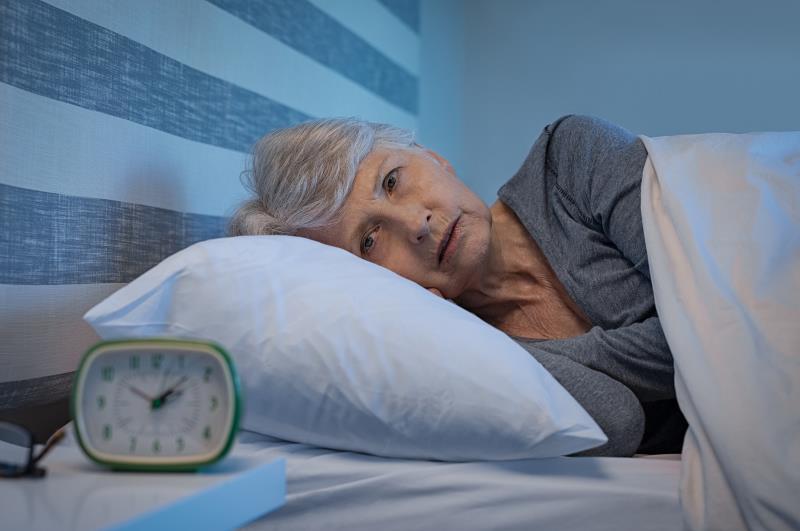
Treatment with lemborexant, a dual orexin receptor antagonist, significantly improves sleep onset and maintenance in older adults with insomnia disorder, according to the SUNRISE 1* trial.
This phase III, double-blind, double-dummy, parallel-group trial involved 1,006 participants with insomnia disorder (median age 63 years, 86 percent female) at 67 sites in North America and Europe. Patients were randomized in a 5:5:5:4 ratio to receive lemborexant 5 mg (n=266) or 10 mg (n=269), zolpidem tartrate extended-release 6.25 mg (n=263), or placebo (n=208) for 30 nights. Polysomnography (PSG) and electronic sleep diaries were used to assess sleep onset (as indicated by latency to persistent sleep [LPS**]) and sleep maintenance outcomes (as indicated by wake-after-sleep onset [WASO***] and sleep efficiency). [JAMA Netw Open 2019;2:e1918254]
As measured by PSG, a significant reduction in LPS was observed among patients treated with lemborexant compared with placebo at the end of treatment (nights 29 and 30; least squares geometric mean [LSGM] treatment ratio, 0.77; p<0.001 for 5 mg and 0.72; p<0.001 for 10 mg).
Patients in the lemborexant arm also had a significantly reduced WASO compared with the placebo arm (least squares mean [LSM] treatment difference, -24.0 minutes; p<0.001 and -25.4 minutes; p<0.001 for 5 and 10 mg, respectively) at nights 29 and 30.
“The reduction in time spent awake was observed mostly in the latter half of the sleep period,” highlighted the researchers. Results showed that patients on lemborexant had a significantly reduced WASO in the second half of the night (WASO2H+) compared with placebo at nights 29 and 30 (LSM treatment difference, -16.4 minutes; p<0.001 for 5 mg and -17.8 minutes; p<0.001 for 10 mg) or compared with zolpidem (LSM treatment difference, -6.7 minutes; p=0.004 for 5 mg and -8.0 minutes; p<0.001 for 10 mg).
“The decreases in sleep-onset latency with lemborexant therapy were notable, as most participants fell asleep in less than 20 minutes, which is typical for those without insomnia,” noted the researchers.
At end of treatment, patients who received lemborexant 5 or 10 mg also showed a significant increase in sleep efficiency than placebo recipients (LSM treatment difference, 7.1; p<0.001 or 8.0; p<0.001, respectively). “The increases in sleep efficiency in both lemborexant treatment groups translated into more than 60 minutes [of] more sleep per night than before treatment,” the researchers noted.
“[Of note,] improvements were also observed for self-reported measures of sleep onset and maintenance compared with placebo, as assessed by sleep diaries … [Overall,] effects were observed at the start of treatment and were maintained at 1 month,” the researchers noted.
Four patients in the lemborexant arm reported sleep paralysis of mild severity. Serious adverse events occurred in four patients in the zolpidem arm and two patients in the lemborexant arm, but none were considered treatment related.
“This … study of lemborexant therapy … achieved its primary and key secondary objectives, demonstrating [subjectively] and objectively that treatment with lemborexant therapy led to greater improvements in both PSG- [and sleep diary-]based sleep onset and sleep maintenance outcomes compared with both placebo and zolpidem therapy,” said the researchers.
“Lemborexant therapy provided more sleep promotion than placebo and zolpidem therapy based on objective and subjective patient-reported measures of sleep onset and maintenance in participants 55 years and older,” they added. “Results of this first head-to-head phase III clinical trial are encouraging and support continued development of lemborexant therapy for the treatment of insomnia disorder.”
*SUNRISE 1: Study of the efficacy and safety of lemborexant in subjects 55 years and older with insomnia disorder
**LPS: Defined as minutes from lights off to the first epoch of 20 consecutive 30-second epochs of non-wakefulness
***WASO: Defined as minutes of wake from LPS until lights on
+WASO2H: Defined as minutes of wake from 240 minutes after lights off until lights on